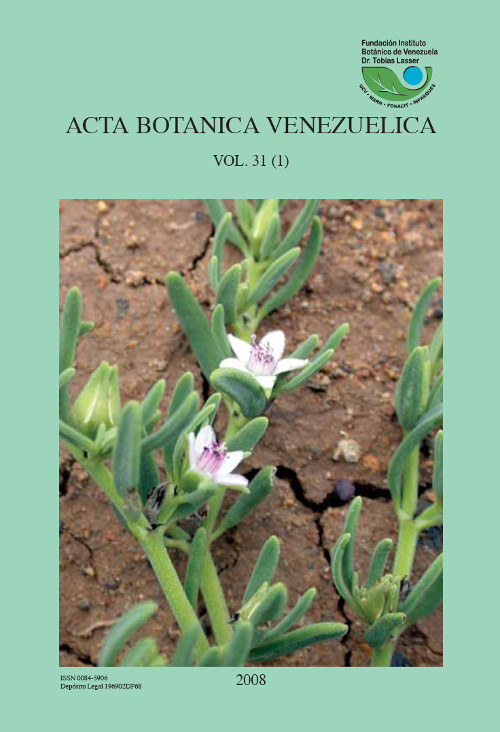HALOFITISMO EN PLANTAS DE LA COSTA CARIBE DE VENEZUELA: HALÓFITAS Y HALOTOLERANTES
Resumen
RESUMEN
Para determinar su grado de halofitismo se analizó la composición mineral y de isótoposestables (13C y 15N) de 18 especies de plantas de comunidades costeras, y de los suelosasociados en tres localidades del estado Falcón,Venezuela, en la carretera Coro-La Vela(COVE); y la costa oriental (COP) y la bahía de Tacuato (TAC), ambas en Paraguaná. Lossuelos de COP presentaron textura arenosa y valores menores de N, P, K y Na. Los suelos deTAC mostraron mayor salinidad (Na, Mg y Ca) y los de COVE tenían concentraciones mayoresde N y P, y textura arcillosa. Las especies de COP tenían las mayores concentraciones deNa, y eran más suculentas (Sesuvium portulacastrum, S. edmondstonii, Batis maritima, Sarcocorniaperennisy Heterostachys ritteriana). Chamaesyce mesembrianthemifoliay Crotonpunctatus tenían cocientes K/Na > 1 (no halófitas). Chamaesyce mesembrianthemifolia,Scaevola plumieri, Argusia gnaphalodes, Egletes prostrata, Suriana maritimay Gomphrenaalbiflora son concentradoras relativas de K. Las especies calciófobas acumulan la mayor partedel Ca como oxalato insoluble (Atriplex oestophora, G. albifloray Alternanthera halimifolia),o secuestrado como fosfatos y pectatos (Croton punctatus, S. portulacastrum y S. edmondstonii,H. ritteriana, E. prostrata y Melochia crenata). Las especies calciófilaspresentaron una fracción de Ca soluble en agua 50% (S. maritima, C. mesembrianthemifolia,S. plumieri, H. curassavicum, Sporobolus virginicusy B. maritima). El δ13C reveló cinco especiescon metabolismo fotosintético C4 (A. halimifolia, G. albiflora, S. virginicus, C. mesembrianthemifoliayA. oestophora). Los altos valores de δ15N sugieren como fuente principalde N al NO3 del suelo. Este trabajo incluye una compilación de especies de plantassuperiores de la costa caribeña de Venezuela con indicaciones sobre su carácter halofítico.
ABSTRACT
To determine their degree of halophytism it was analyzed the mineral composition andstable isotopes (13C, and 15N) of leaf material and associated soils of 18 species of coastal plantspecies in three locations in Falcon State,Venezuela (Coro-La Vela road, COVE; east coast ofParaguaná, COP, and Tacuato bay in Paraguaná, TAC). COP soils were sandy and had the lowestconcentrations of N, P, K and Na. TAC soils showed higher salinity (Na, Mg and Ca),whereas those of COVE had higher N and P concentrations and clay texture. COP species had the highest Na concentrations and were more succulent (Sesuvium portulacastrum, S. edmondstonii,Batis maritima, Sarcocornia perennis and Heterostachys ritteriana). Chamaesycemesembrianthemifolia and Croton punctatus had leaf K/Na ratios > 1 (non halophytes).Chamaesyce mesembrianthemifolia, Scaevola plumieri, Argusia gnaphalodes,Egletes prostrata, Suriana maritima, and Gomphrena albiflora were relative K accumulators.Calciophobes accumulated most Ca in form of water insoluble oxalate (Atriplex oestophora,G. albiflora and Alternanthera halimifolia), or sequestered in form of phosphates andpectates (Croton punctatus, S. portulacastrum and S. edmondstonii, H. ritteriana, E. prostrata,and Melochia crenata). Calciophile species had a water soluble Ca fraction ≥ 50% (S. maritima,C. mesembrianthemifolia, S. plumieri, H. curassavicum, Sporobolus virginicusand B.maritima). The δ13C values revealed five species with C4-photosynthesis (A. halimifolia, G.albiflora, S. virginicus, C. mesembrianthemifolia and A. oestophora). The positive values ofδ15N suggest soil NO3 as the main N source. This paper includes a compilation of higher plantspecies of the Caribbean coast of Venezuela with indications of their halophytic character.
Descargas
Descargas
Número
Sección
Licencia
© Instituto Experimental Jardín Botánico "Dr. Tobías Lasser" |


